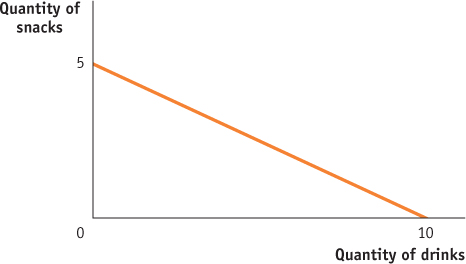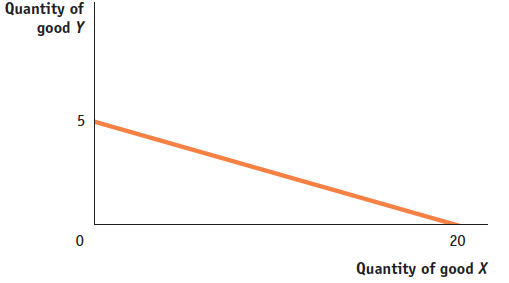Tackle the Test: Free-Response Questions
Question
Refer to the table provided. Assume you have $20 to spend.
Snacks (price = $4) Drinks (price = $2) Quantity Total Utility (utils) Quantity Total Utility (utils) 1 15 1 12 2 25 2 21 3 31 3 29 4 34 4 36 5 36 5 42 6 47 7 50 8 52 Draw a correctly labeled budget line.
Determine the marginal utility and the marginal utility per dollar spent on the fourth drink.
What is the optimal consumption rule?
How many drinks and snacks should you purchase to maximize your total utility?
Rubric for FRQ 1 (6 points)

1 point: Graph with “Quantity of snacks” and “Quantity of drinks” as axis labels
1 point: Straight budget line with intercepts at 5 snacks and 0 drinks and at 0 snacks and 10 drinks
1 point: MU = 7 utils
1 point: MU/P = 3.5 utils per dollar
1 point: Total utility is maximized when the marginal utility per dollar is equal for all goods.
1 point: 6 drinks, 2 snacks
Question
Assume you have an income of $100. The price of good X is $5, and the price of good Y is $20.
Draw a correctly labeled budget line with “Quantity of good X” on the horizontal axis and “Quantity of good Y” on the vertical axis. Be sure to correctly label the horizontal and vertical intercepts.
With your current consumption bundle, you spend all of your income and receive 100 utils from consuming your last unit of good X and 400 utils from consuming your last unit of good Y. Are you maximizing your total utility? Explain.
What will happen to the total and marginal utility you receive from consuming good X if you decide to consume another unit of good X? Explain. (4 points)
Rubric for FRQ 2 (4 points)

1 point: Graph with “Quantity of good X” on the horizontal axis, “Quantity of good Y” on the vertical axis, and a straight budget line
1 point: Intercepts correctly labeled at 5 units of good Y and 0 units of good X and at 0 units of good Y and 20 units of good X
1 point: Yes, because this consumption bundle satisfies the optimal consumption rule:
100/$5 = 400/$20
1 point: Total utility will increase because marginal utility is positive, while marginal utility will decrease due to the principle of diminishing marginal utility.